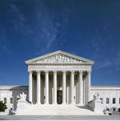Constitutional Law and Intellectual Property Law Professors Call on Supreme Court to Review Davis
By Jennifer E. RothmanNovember 4, 2015

Professor Eugene Volokh (UCLA) and I filed a brief today in support of granting certiorari in Davis v. Electronic Arts. The brief was signed on to by many leading constitutional law and IP law scholars. We call on the Supreme Court to address the disarray among lower courts about how to analyze the First Amendment defense to right of publicity claims. This is particularly true when claims arise out of the realistic portrayal of people in expressive works. In the brief, we highlight the vast array of speech jeopardized by right of publicity claims, including books, films, songs, artwork, and videogames. The Supreme Court has not considered the right of publicity since its 1977 decision in Zacchini v. Scripps-Howard Broadcasting, and that case only addressed the narrow issue of whether there was a First Amendment defense when a performer’s entire act was used. Because the Court rejected a First Amendment defense in Zacchini under those limited circumstances, many lower courts have been left without direction as to how to evaluate the right of publicity’s speech-limiting effects when only a name or likeness is used. At least five different and irreconcilable tests have been developed in the lower courts. These include the Transformative Use test (adopted by the Third and Ninth Circuits), the Transformative Work Test (adopted by California), the Relatedness Test (adopted by the Second, Fifth and Sixth Circuits), the Predominant Purpose Test (adopted by Missouri), and the Balancing Test (adopted by the Eight, Tenth and Eleventh Circuits). The outcome of various cases depends on which of these tests apply; for example, the Eight Circuit’s balancing approach led to a conclusion that online fantasy sports games that used players’ names and statistics were protected by the First Amendment, but the Third and Ninth Circuit’s transformative use approach held that similar uses were not protected in the context of videogames. The California Supreme Court held under its transformative work test that the use of musicians’ names and likenesses in a comic book was protected by the First Amendment, but the Missouri Supreme Court held a similar use not protected under its predominant use test. It’s time for the Supreme Court to step in to fix this mess and provide guidance. Otherwise, the chilling effect of these contradictory and unpredictable tests will limit a wide range of expression in movies, plays, novels, songs, videogames, documentaries and more. We also advocate that the Court harmonize First Amendment analysis across false endorsement (under the Lanham Act) and right of publicity claims since these causes of action are often pled together and false endorsement claims can easily be reframed as right of publicity ones. The Respondents received an extension until December 8, 2015 to file their response, but the Supreme Court still will likely consider whether to grant review at its January conference. Hopefully, the justices will agree with us that the time for review is now.
